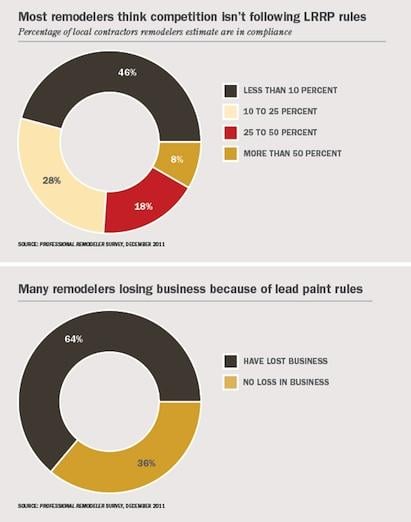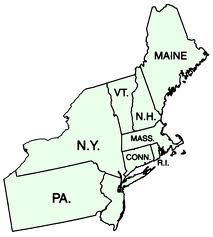NARI Member Testifies Before Small Business Committee About Frustrations With EPA

Yesterday, David Merrick, chairman of the NARI Government Affairs Committee and owner of Merrick Design and Build, testified before the House Small Business Committee about many of the concerns remodelers' have about the RRP Rule and the difficulties trying to effectively work with EPA. I think David’s testimony spoke for the opinions of most NARI Members as well as for most remodelers. Let me know what you think.
Click here to view the entire video which was just over one hour long. David’s introduction and his testimony begin at about 19:50.
Here are some highlights I pulled from watching the video myself.
In response to questions posed by a representative overseeing the SBA (Ms. Peters?), David stands up for and points out the realities and challenges for smaller one or two man remodeling businesses starting at about 30:28. David stressed the burden record keeping has on such smaller businesses just trying to earn enough money within the time they have to produce their product, pointing out that even if they are doing the right things regarding the work they perform, they can be punished by EPA for paperwork challenges.

Many might miss this watching the video, but I think it exposes the lack of understanding many of those in our government have about the nature of the remodeling industry and the businesses that participate in the industry. The same representative overseeing the SBA (Ms. Peters?) made the following comment at about 33:10 in what I observed to be an obvious effort to be sarcastic;
“And when I get my bid from a contractor on remodeling should I triple the time and double the money? (She laughs) Just Kidding…”
Perhaps, like many contractors, EPA has a problem under estimating and under bidding?
 At 58:56 Mr. Tipton asks: “So, effectively what you are saying is if the EPA is asking for input maybe it would be a good idea if they listened? To that question Merrick replied that the EPA is always gracious about meeting with NARI and taking their input, but he further clarifies his response by commenting “They take our comments and disappear behind doors and we never hear from them again.”
At 58:56 Mr. Tipton asks: “So, effectively what you are saying is if the EPA is asking for input maybe it would be a good idea if they listened? To that question Merrick replied that the EPA is always gracious about meeting with NARI and taking their input, but he further clarifies his response by commenting “They take our comments and disappear behind doors and we never hear from them again.”
I think it is worth listening to the balance of the video after Merrick’s comment to hear Mr. Tipton’s comments and opinions in support of more sensible oversight of EPA’s tactics, behavior, attitudes and performance.
Give EPA more money?
During the hearing there was much banter regarding whether EPA needs more money to effectively regulate or alternately should get less money because of their poor performance. I think they are missing the point. We don’t have more money to give EPA unless we take it from somewhere else or borrow it from China and put the burden of paying for the borrowed money on our children’s future. Maybe many of the the same children the rule is intended to protect.
Here is one example. During the hearing Merrick points out That currently only 122,476 firms in the remodeling sector are considered EPA Lead-Certified Firms, out of the estimated 652,206 remodeling businesses in the United States. Has EPA done a good job in the past 26 months since the rule took effect if 80% of remodeling contractors are still operating uncertified? Are they really keeping our children safe from lead poisoning with the plan they assembled knowing the reality of available funding?
I think it goes back to original planning. Try this analogy.

The simple way to put it is it’s great to figure out and plan for a nice seafood lobster dinner, but if you get to the store and you don’t have enough money then all that planning on a great seafood dinner is kind of wasted. My suggestion is that the way EPA went about creating this rule is rather silly especially because they just don’t have the funding or the budget to administer and enforce the rule the way the rule was written.
Perhaps if EPA really understood our industry and how contractors operate, they would have considered a Design/Build approach!
Thanks David.
Click here for a NARI Press Release about the hearing

 Looking for accurate information about the EPA RRP rule?
Looking for accurate information about the EPA RRP rule? 
 In reality what they have done has not been effective. Either the message is not effective, the placement is not effective or both. According to a
In reality what they have done has not been effective. Either the message is not effective, the placement is not effective or both. According to a 

 So far EPA has only published one violation since the rule came into effect in April of 2010. On the other hand the state of Massachusetts took over the rule in July of 2012 and has
So far EPA has only published one violation since the rule came into effect in April of 2010. On the other hand the state of Massachusetts took over the rule in July of 2012 and has  It is a fact that lead is poisonous and RRP activities can cause poisoning. However, EPA does not know how many children were actually poisoned by RRP activities before the rule came into effect. If you check any of the data it refers to RRP activities as the “likely source” of lead poisoning, not “the cause”. That being the case, EPA has no way to know if the RRP rule is making a difference or not. It is ‘likely” that it is helping. But, without knowing where EPA started and where we are now that the rule has been in place for almost a year, EPA has no idea if what they have been doing is effective enough and or if or where it can improve effectiveness within the rule.
It is a fact that lead is poisonous and RRP activities can cause poisoning. However, EPA does not know how many children were actually poisoned by RRP activities before the rule came into effect. If you check any of the data it refers to RRP activities as the “likely source” of lead poisoning, not “the cause”. That being the case, EPA has no way to know if the RRP rule is making a difference or not. It is ‘likely” that it is helping. But, without knowing where EPA started and where we are now that the rule has been in place for almost a year, EPA has no idea if what they have been doing is effective enough and or if or where it can improve effectiveness within the rule.  A recent survey by the National Association of the Remodeling Industry shows that a full majority of members responding to the survey agreed with the
A recent survey by the National Association of the Remodeling Industry shows that a full majority of members responding to the survey agreed with the  The NARI press release also clarified that NARI continues to work actively with the EPA on ways the agency can educate the public on the importance of hiring EPA-certified remodelers to do work on homes built before 1978. NARI has been and continues to push the agency for tougher enforcement of the rules to crack down on firms lacking the required EPA certification that are violating the rule and failing to protect homeowners.
The NARI press release also clarified that NARI continues to work actively with the EPA on ways the agency can educate the public on the importance of hiring EPA-certified remodelers to do work on homes built before 1978. NARI has been and continues to push the agency for tougher enforcement of the rules to crack down on firms lacking the required EPA certification that are violating the rule and failing to protect homeowners.

 Both sides of this issue have valid points to consider. Before we make rash decisions have we looked at the entire picture? We can do better than our politicians, but we must think before we act.
Both sides of this issue have valid points to consider. Before we make rash decisions have we looked at the entire picture? We can do better than our politicians, but we must think before we act. Whether the Opt Out comes back or not, what about the employees of the firms who intend on using this option? Did anyone ask those who are actually doing the work how they feel about their health risks? Will they have a voice without retaliation?
Whether the Opt Out comes back or not, what about the employees of the firms who intend on using this option? Did anyone ask those who are actually doing the work how they feel about their health risks? Will they have a voice without retaliation? I believe this law can create marketing and positioning opportunities to those who see it this way and in the process, keeps everyone safe – and for those who see it differently, it’s obviously a never ending source of complaints which has divided our industry at a time when we need each others’ back more than ever.
I believe this law can create marketing and positioning opportunities to those who see it this way and in the process, keeps everyone safe – and for those who see it differently, it’s obviously a never ending source of complaints which has divided our industry at a time when we need each others’ back more than ever.


 Of the 1,500+ remodeling contractor respondents, only 25% reported doing any lead clearance testing at all. Regardless of cost variations, the majority of respondents reported that significant cost is added to a home improvement project with the addition of lead clearance testing.
Of the 1,500+ remodeling contractor respondents, only 25% reported doing any lead clearance testing at all. Regardless of cost variations, the majority of respondents reported that significant cost is added to a home improvement project with the addition of lead clearance testing. Why we did the surveys: We believe what all of you are saying out there, and we've been hearing your comments in blogs, social media, by talking to you directly. However, when trying to bring an issue to light in Washington, officials want current data to review, and providing anecdotal data as heard from third parties is typically seen as not credible, hence the surveys. NARI is sharing results of the research on Capitol Hill that EPA's implementation of the Renovation, Repair, and Painting rules may increase the likelihood of lead poisoning to children, as opposed to lowering the risk. Adding to this risk is the expected forthcoming of the Lead Clearance Rule, which will only exacerbate the problem. Additionally, NARI is reaching out to small business interest groups in Washington and media nationwide to make them aware of the survey results and how the rule is impacting your business.
Why we did the surveys: We believe what all of you are saying out there, and we've been hearing your comments in blogs, social media, by talking to you directly. However, when trying to bring an issue to light in Washington, officials want current data to review, and providing anecdotal data as heard from third parties is typically seen as not credible, hence the surveys. NARI is sharing results of the research on Capitol Hill that EPA's implementation of the Renovation, Repair, and Painting rules may increase the likelihood of lead poisoning to children, as opposed to lowering the risk. Adding to this risk is the expected forthcoming of the Lead Clearance Rule, which will only exacerbate the problem. Additionally, NARI is reaching out to small business interest groups in Washington and media nationwide to make them aware of the survey results and how the rule is impacting your business. From March through June 2011, a dedicated work group of NARI members regularly convened for the purpose of documenting challenges in the application of EPA's Lead Renovation, Repair and Painting Rule (LRRP Rule). NARI's purpose is to convey to the EPA what is working and what is not working in implementation and to make recommendations. The work group identified the following prioritized concerns with recommendations:
From March through June 2011, a dedicated work group of NARI members regularly convened for the purpose of documenting challenges in the application of EPA's Lead Renovation, Repair and Painting Rule (LRRP Rule). NARI's purpose is to convey to the EPA what is working and what is not working in implementation and to make recommendations. The work group identified the following prioritized concerns with recommendations: Thanks to PR activities by NARI, Wall Street Journal Blogger
Thanks to PR activities by NARI, Wall Street Journal Blogger  Many point out that one of the consequences of the rule is that now more children have been put at risk for lead poisoning; for two reasons. The first is due to the fact that illegally operating contractors are under-bidding compliant contractors because they are ignoring the required lead-safe work practices and therefore creating lead hazards. The second is that homeowners are either doing the work themselves and or doing the demolition stage of the work themselves to avoid the added costs related to the rule’s required lead-safe work practices.
Many point out that one of the consequences of the rule is that now more children have been put at risk for lead poisoning; for two reasons. The first is due to the fact that illegally operating contractors are under-bidding compliant contractors because they are ignoring the required lead-safe work practices and therefore creating lead hazards. The second is that homeowners are either doing the work themselves and or doing the demolition stage of the work themselves to avoid the added costs related to the rule’s required lead-safe work practices. As Ben Franklin once said: “We must all hang together, or assuredly we shall all hang separately.”
As Ben Franklin once said: “We must all hang together, or assuredly we shall all hang separately.” At a RRP workshop I attended last week, sponsored by the Lead and Environmental Hazards Association (LEHA), several renovators complained to Mike Wilson of EPA about EPA’s handling so far of the RRP rule. One after the other renovators cited examples of projects they had lost to other businesses that are ignoring the rule. Several even reported home owners had laughed at them when they tried discussing the rule and its requirements. One attendee reported that a homeowner actually told him that he would find another contractor who would ignore the rule as a way of saving money. It all seemed to be new news to Mike Wilson who told us he oversees RRP Policy, so could not comment specifically about enforcement. When asked what message he would bring back to the EPA in Washington after the meeting, Mike said he would let them know that regulated contractors wanted a level playing field. Attendees let Mike know that they have been already giving that same message to EPA, perhaps if Mike delivers the message the leadership at EPA will listen and take action.
At a RRP workshop I attended last week, sponsored by the Lead and Environmental Hazards Association (LEHA), several renovators complained to Mike Wilson of EPA about EPA’s handling so far of the RRP rule. One after the other renovators cited examples of projects they had lost to other businesses that are ignoring the rule. Several even reported home owners had laughed at them when they tried discussing the rule and its requirements. One attendee reported that a homeowner actually told him that he would find another contractor who would ignore the rule as a way of saving money. It all seemed to be new news to Mike Wilson who told us he oversees RRP Policy, so could not comment specifically about enforcement. When asked what message he would bring back to the EPA in Washington after the meeting, Mike said he would let them know that regulated contractors wanted a level playing field. Attendees let Mike know that they have been already giving that same message to EPA, perhaps if Mike delivers the message the leadership at EPA will listen and take action. On the other hand, since taking over the RRP Rule in MA, working with MA state officials has been much more productive. The Massachusetts Department of Labor Standards (DLS), formally called the Massachusetts Division of Occupational Safety, under the leadership of the department's Director Heather Rowe, has been very receptive to meeting with concerned stakeholders, hearing and recognizing stakeholder's concerns, and working with stakeholders to address their concerns. Currently, in addition to working on amendments to the RRP regulations in MA to address concerns, the DLS is also finalizing their plans to step up enforcement and compliance actions this spring as the home improvement season begins. Is it happening as fast as we all might like, no. However, based on budget and resource realities, I think DLS is doing a good job listening and prioritizing their efforts.
On the other hand, since taking over the RRP Rule in MA, working with MA state officials has been much more productive. The Massachusetts Department of Labor Standards (DLS), formally called the Massachusetts Division of Occupational Safety, under the leadership of the department's Director Heather Rowe, has been very receptive to meeting with concerned stakeholders, hearing and recognizing stakeholder's concerns, and working with stakeholders to address their concerns. Currently, in addition to working on amendments to the RRP regulations in MA to address concerns, the DLS is also finalizing their plans to step up enforcement and compliance actions this spring as the home improvement season begins. Is it happening as fast as we all might like, no. However, based on budget and resource realities, I think DLS is doing a good job listening and prioritizing their efforts. As one way to continue their efforts and interact with stakeholders, the Massachusetts Department of Labor Standards is looking for additional input from contractors and lead industry practitioners in anticipation of making amendments to the MA RRP regulations. An official from this agency will be participating in a May 18 workshop on the RRP Rule being held in Marlborough, MA sponsored by the Lead and Environmental Hazards Association (LEHA) and will be discussing the Department’s plans for revising the RRP regulations as well as the Department's enforcement efforts.
As one way to continue their efforts and interact with stakeholders, the Massachusetts Department of Labor Standards is looking for additional input from contractors and lead industry practitioners in anticipation of making amendments to the MA RRP regulations. An official from this agency will be participating in a May 18 workshop on the RRP Rule being held in Marlborough, MA sponsored by the Lead and Environmental Hazards Association (LEHA) and will be discussing the Department’s plans for revising the RRP regulations as well as the Department's enforcement efforts.


